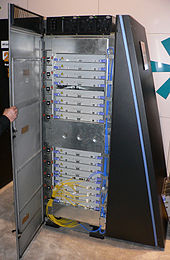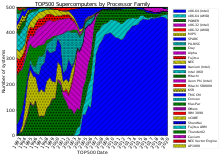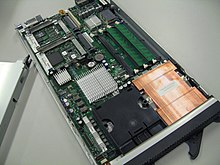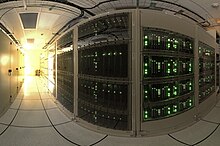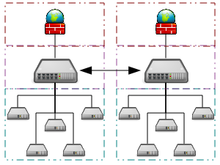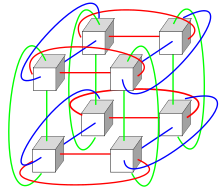A supercomputer is a computer with a high-level computational capacity. Performance of a supercomputer is measured infloating point operations per second (FLOPS). As of 2015, there are supercomputers which can perform up to quadrillions of FLOPS.[2]
Supercomputers were introduced in the 1960s, made initially, and for decades primarily, by Seymour Cray at Control Data Corporation (CDC), Cray Research and subsequent companies bearing his name or monogram. While the supercomputers of the 1970s used only a few processors, in the 1990s machines with thousands of processors began to appear and, by the end of the 20th century, massively parallel supercomputers with tens of thousands of "off-the-shelf" processors were the norm.[3][4] Since its introduction in June 2013, China's Tianhe-2 supercomputer is currently the fastest in the world at 33.86 petaFLOPS (PFLOPS), or 33.86 quadrillion floating point operations per second.
Supercomputers play an important role in the field of computational science, and are used for a wide range of computationally intensive tasks in various fields, including quantum mechanics, weather forecasting, climate research, oil and gas exploration, molecular modeling (computing the structures and properties of chemical compounds, biologicalmacromolecules, polymers, and crystals), and physical simulations (such as simulations of the early moments of the universe, airplane and spacecraft aerodynamics, the detonation of nuclear weapons, and nuclear fusion). Throughout their history, they have been essential in the field of cryptanalysis.[5]
Systems with massive numbers of processors generally take one of two paths: In one approach (e.g., in distributed computing), a large number of discrete computers (e.g.,laptops) distributed across a network (e.g., the Internet) devote some or all of their time to solving a common problem; each individual computer (client) receives and completes many small tasks, reporting the results to a central server which integrates the task results from all the clients into the overall solution.[6][7] In another approach, a large number of dedicated processors are placed in close proximity to each other (e.g. in a computer cluster); this saves considerable time moving data around and makes it possible for the processors to work together (rather than on separate tasks), for example in mesh and hypercube architectures.
The use of multi-core processors combined with centralization is an emerging trend; one can think of this as a small cluster (the multicore processor in a smartphone, tablet, laptop, etc.) that both depends upon and contributes to the cloud.[8][9]
Contents
[hide]- 1 History
- 2 Hardware and architecture
- 3 Software and system management
- 4 Distributed supercomputing
- 5 Performance measurement
- 6 Largest Supercomputer Vendors according to the total Rmax (GFLOPS) operated
- 7 Applications
- 8 Research and development trends
- 9 Energy use
- 10 See also
- 11 Notes and references
- 12 External links
History[edit]
The history of supercomputing goes back to the 1960s, with the Atlas at the University of Manchester and a series of computers atControl Data Corporation (CDC), designed by Seymour Cray. These used innovative designs and parallelism to achieve superior computational peak performance.[10]
The Atlas was a joint venture between Ferranti and the Manchester University and was designed to operate at processing speeds approaching one microsecond per instruction, about one million instructions per second.[11] The first Atlas was officially commissioned on 7 December 1962 as one of the world's first supercomputers – considered to be the most powerful computer in the world at that time by a considerable margin, and equivalent to four IBM 7094s.[12]
The CDC 6600, released in 1964, was designed by Cray to be the fastest in the world by a large margin. Cray switched from germanium to silicon transistors, which he ran very fast, solving the overheating problem by introducing refrigeration.[13] Given that the 6600 outran all computers of the time by about 10 times, it was dubbed a supercomputer and defined the supercomputing market when one hundred computers were sold at $8 million each.[14][15][16][17]
Cray left CDC in 1972 to form his own company, Cray Research.[15] Four years after leaving CDC, Cray delivered the 80 MHz Cray 1 in 1976, and it became one of the most successful supercomputers in history.[18][19] The Cray-2 released in 1985 was an 8 processor liquid cooled computer and Fluorinert was pumped through it as it operated. It performed at 1.9 gigaflops and was the world's fastest until 1990.[20]
While the supercomputers of the 1980s used only a few processors, in the 1990s, machines with thousands of processors began to appear both in the United States and Japan, setting new computational performance records. Fujitsu's Numerical Wind Tunnel supercomputer used 166 vector processors to gain the top spot in 1994 with a peak speed of 1.7 gigaFLOPS (GFLOPS) per processor.[21][22] The Hitachi SR2201 obtained a peak performance of 600 GFLOPS in 1996 by using 2048 processors connected via a fast three-dimensional crossbar network.[23][24][25] The Intel Paragon could have 1000 to 4000 Intel i860 processors in various configurations, and was ranked the fastest in the world in 1993. The Paragon was a MIMD machine which connected processors via a high speed two dimensional mesh, allowing processes to execute on separate nodes, communicating via the Message Passing Interface.[26]
Hardware and architecture[edit]
Approaches to supercomputer architecture have taken dramatic turns since the earliest systems were introduced in the 1960s. Early supercomputer architectures pioneered by Seymour Cray relied on compact innovative designs and local parallelism to achieve superior computational peak performance.[10] However, in time the demand for increased computational power ushered in the age of massively parallelsystems.
While the supercomputers of the 1970s used only a few processors, in the 1990s, machines with thousands of processors began to appear and by the end of the 20th century, massively parallel supercomputers with tens of thousands of "off-the-shelf" processors were the norm. Supercomputers of the 21st century can use over 100,000 processors (some being graphic units) connected by fast connections.[3][4] The Connection Machine CM-5 supercomputer is a massively parallel processing computer capable of many billions of arithmetic operations per second.[27]
Throughout the decades, the management of heat density has remained a key issue for most centralized supercomputers.[28][29][30] The large amount of heat generated by a system may also have other effects, e.g. reducing the lifetime of other system components.[31] There have been diverse approaches to heat management, from pumping Fluorinert through the system, to a hybrid liquid-air cooling system or air cooling with normal air conditioning temperatures.[20][32]
Systems with a massive number of processors generally take one of two paths. In the grid computing approach, the processing power of a large number of computers, organised as distributed, diverse administrative domains, is opportunistically used whenever a computer is available.[6] In another approach, a large number of processors are used in close proximity to each other, e.g. in a computer cluster. In such a centralized massively parallel system the speed and flexibility of the interconnect becomes very important and modern supercomputers have used various approaches ranging from enhanced Infiniband systems to three-dimensional torus interconnects.[33][34] The use of multi-core processors combined with centralization is an emerging direction, e.g. as in the Cyclops64system.[8][9]
As the price, performance and energy efficiency of general purpose graphic processors (GPGPUs) have improved,[35] a number ofpetaflop supercomputers such as Tianhe-I and Nebulae have started to rely on them.[36] However, other systems such as the K computer continue to use conventional processors such as SPARC-based designs and the overall applicability of GPGPUs in general-purpose high-performance computing applications has been the subject of debate, in that while a GPGPU may be tuned to score well on specific benchmarks, its overall applicability to everyday algorithms may be limited unless significant effort is spent to tune the application towards it.[37] However, GPUs are gaining ground and in 2012 the Jaguar supercomputer was transformed into Titan by retrofitting CPUs with GPUs.[38][39][40]
High performance computers have an expected life cycle of about three years.[41]
A number of "special-purpose" systems have been designed, dedicated to a single problem. This allows the use of specially programmed FPGA chips or even custom VLSIchips, allowing better price/performance ratios by sacrificing generality. Examples of special-purpose supercomputers include Belle,[42] Deep Blue,[43] and Hydra,[44] for playingchess, Gravity Pipe for astrophysics,[45] MDGRAPE-3 for protein structure computation molecular dynamics[46] and Deep Crack,[47] for breaking the DES cipher.
Energy usage and heat management[edit]
A typical supercomputer consumes large amounts of electrical power, almost all of which is converted into heat, requiring cooling. For example, Tianhe-1A consumes 4.04 megawatts of electricity.[48] The cost to power and cool the system can be significant, e.g. 4 MW at $0.10/kWh is $400 an hour or about $3.5 million per year.
Heat management is a major issue in complex electronic devices, and affects powerful computer systems in various ways.[49] Thethermal design power and CPU power dissipation issues in supercomputing surpass those of traditional computer cooling technologies. The supercomputing awards for green computing reflect this issue.[50][51][52]
The packing of thousands of processors together inevitably generates significant amounts of heat density that need to be dealt with. The Cray 2 was liquid cooled, and used a Fluorinert "cooling waterfall" which was forced through the modules under pressure.[20]However, the submerged liquid cooling approach was not practical for the multi-cabinet systems based on off-the-shelf processors, and in System X a special cooling system that combined air conditioning with liquid cooling was developed in conjunction with the Liebert company.[32]
In the Blue Gene system, IBM deliberately used low power processors to deal with heat density.[53] On the other hand, the IBM Power 775, released in 2011, has closely packed elements that require water cooling.[54] The IBM Aquasar system, on the other hand uses hot water cooling to achieve energy efficiency, the water being used to heat buildings as well.[55][56]
The energy efficiency of computer systems is generally measured in terms of "FLOPS per watt". In 2008, IBM's Roadrunner operated at 3.76 MFLOPS/W.[57][58] In November 2010, the Blue Gene/Q reached 1,684 MFLOPS/W.[59][60] In June 2011 the top 2 spots on the Green 500 list were occupied by Blue Gene machines in New York (one achieving 2097 MFLOPS/W) with the DEGIMA cluster in Nagasaki placing third with 1375 MFLOPS/W.[61]
Because copper wires can transfer energy into a supercomputer with much higher power densities than forced air or circulating refrigerants can remove waste heat,[62] the ability of the cooling systems to remove waste heat is a limiting factor.[63][64] As of 2015, many existing supercomputers have more infrastructure capacity than the actual peak demand of the machine – people conservatively designed the power and cooling infrastructure to handle more than the theoretical peak electrical power consumed by the supercomputer. Designs for future supercomputers are power-limited – the thermal design power of the supercomputer as a whole, the amount that the power and cooling infrastructure can handle, is somewhat more than the expected normal power consumption, but less than the theoretical peak power consumption of the electronic hardware.[65]
Software and system management[edit]
Operating systems[edit]
Since the end of the 20th century, supercomputer operating systems have undergone major transformations, based on the changes in supercomputer architecture.[66] While early operating systems were custom tailored to each supercomputer to gain speed, the trend has been to move away from in-house operating systems to the adaptation of generic software such as Linux.[67]
Since modern massively parallel supercomputers typically separate computations from other services by using multiple types of nodes, they usually run different operating systems on different nodes, e.g. using a small and efficient lightweight kernel such as CNK or CNL on compute nodes, but a larger system such as a Linux-derivative on server and I/O nodes.[68][69][70]
While in a traditional multi-user computer system job scheduling is, in effect, a tasking problem for processing and peripheral resources, in a massively parallel system, the job management system needs to manage the allocation of both computational and communication resources, as well as gracefully deal with inevitable hardware failures when tens of thousands of processors are present.[71]
Although most modern supercomputers use the Linux operating system, each manufacturer has its own specific Linux-derivative, and no industry standard exists, partly due to the fact that the differences in hardware architectures require changes to optimize the operating system to each hardware design.[66][72]
Software tools and message passing[edit]
The parallel architectures of supercomputers often dictate the use of special programming techniques to exploit their speed. Software tools for distributed processing include standard APIs such as MPI and PVM, VTL, and open source-based software solutions such asBeowulf.
In the most common scenario, environments such as PVM and MPI for loosely connected clusters and OpenMP for tightly coordinated shared memory machines are used. Significant effort is required to optimize an algorithm for the interconnect characteristics of the machine it will be run on; the aim is to prevent any of the CPUs from wasting time waiting on data from other nodes. GPGPUs have hundreds of processor cores and are programmed using programming models such as CUDA.
Moreover, it is quite difficult to debug and test parallel programs. Special techniques need to be used for testing and debugging such applications.
Distributed supercomputing[edit]
Opportunistic approaches[edit]
Opportunistic Supercomputing is a form of networked grid computing whereby a "super virtual computer" of many loosely coupledvolunteer computing machines performs very large computing tasks. Grid computing has been applied to a number of large-scaleembarrassingly parallel problems that require supercomputing performance scales. However, basic grid and cloud computingapproaches that rely on volunteer computing can not handle traditional supercomputing tasks such as fluid dynamic simulations.
The fastest grid computing system is the distributed computing project Folding@home. F@h reported 43.1 PFLOPS of x86 processing power as of June 2014. Of this, 42.5 PFLOPS are contributed by clients running on various GPUs, and the rest from various CPU systems.[74]
The BOINC platform hosts a number of distributed computing projects. As of May 2011, BOINC recorded a processing power of over 5.5 PFLOPS through over 480,000 active computers on the network[75] The most active project (measured by computational power),MilkyWay@home, reports processing power of over 700 teraFLOPS (TFLOPS) through over 33,000 active computers.[76]
As of May 2011, GIMPS's distributed Mersenne Prime search currently achieves about 60 TFLOPS through over 25,000 registered computers.[77] The Internet PrimeNet Server supports GIMPS's grid computing approach, one of the earliest and most successful grid computing projects, since 1997.
Quasi-opportunistic approaches[edit]
Quasi-opportunistic supercomputing is a form of distributed computing whereby the “super virtual computer” of a large number of networked geographically disperse computers performs computing tasks that demand huge processing power.[78] Quasi-opportunistic supercomputing aims to provide a higher quality of service thanopportunistic grid computing by achieving more control over the assignment of tasks to distributed resources and the use of intelligence about the availability and reliability of individual systems within the supercomputing network. However, quasi-opportunistic distributed execution of demanding parallel computing software in grids should be achieved through implementation of grid-wise allocation agreements, co-allocation subsystems, communication topology-aware allocation mechanisms, fault tolerant message passing libraries and data pre-conditioning.[78]
Performance measurement[edit]
Capability vs capacity[edit]
Supercomputers generally aim for the maximum in capability computing rather than capacity computing. Capability computing is typically thought of as using the maximum computing power to solve a single large problem in the shortest amount of time. Often a capability system is able to solve a problem of a size or complexity that no other computer can, e.g. a very complex weather simulation application.[79]
Capacity computing, in contrast, is typically thought of as using efficient cost-effective computing power to solve a small number of somewhat large problems or a large number of small problems.[79] Architectures that lend themselves to supporting many users for routine everyday tasks may have a lot of capacity, but are not typically considered supercomputers, given that they do not solve a single very complex problem.[79]
Performance metrics[edit]
In general, the speed of supercomputers is measured and benchmarked in "FLOPS" (FLoating point Operations Per Second), and not in terms of "MIPS" (Million Instructions Per Second), as is the case with general-purpose computers.[80] These measurements are commonly used with an SI prefix such as tera-, combined into the shorthand "TFLOPS" (1012 FLOPS, pronounced teraflops), or peta-, combined into the shorthand "PFLOPS" (1015 FLOPS, pronounced petaflops.) "Petascale" supercomputers can process one quadrillion (1015) (1000 trillion) FLOPS. Exascale is computing performance in the exaFLOPS (EFLOPS) range. An EFLOPS is one quintillion (1018) FLOPS (one million TFLOPS).
No single number can reflect the overall performance of a computer system, yet the goal of the Linpack benchmark is to approximate how fast the computer solves numerical problems and it is widely used in the industry.[81] The FLOPS measurement is either quoted based on the theoretical floating point performance of a processor (derived from manufacturer's processor specifications and shown as "Rpeak" in the TOP500 lists) which is generally unachievable when running real workloads, or the achievable throughput, derived from the LINPACK benchmarks and shown as "Rmax" in the TOP500 list. The LINPACK benchmark typically performs LU decomposition of a large matrix. The LINPACK performance gives some indication of performance for some real-world problems, but does not necessarily match the processing requirements of many other supercomputer workloads, which for example may require more memory bandwidth, or may require better integer computing performance, or may need a high performance I/O system to achieve high levels of performance.[81]
The TOP500 list[edit]
Since 1993, the fastest supercomputers have been ranked on the TOP500 list according to their LINPACK benchmark results. The list does not claim to be unbiased or definitive, but it is a widely cited current definition of the "fastest" supercomputer available at any given time.
This is a recent list of the computers which appeared at the top of the TOP500 list,[82] and the "Peak speed" is given as the "Rmax" rating. For more historical data see History of supercomputing.
| Year | Supercomputer | Peak speed (Rmax) | Location |
|---|---|---|---|
| 2013 | NUDT Tianhe-2 | 33.86 PFLOPS | Guangzhou, China |
| 2012 | Cray Titan | 17.59 PFLOPS | Oak Ridge, U.S. |
| 2012 | IBM Sequoia | 17.17 PFLOPS | Livermore, U.S. |
| 2011 | Fujitsu K computer | 10.51 PFLOPS | Kobe, Japan |
| 2010 | Tianhe-IA | 2.566 PFLOPS | Tianjin, China |
| 2009 | Cray Jaguar | 1.759 PFLOPS | Oak Ridge, U.S. |
| 2008 | IBM Roadrunner | 1.026 PFLOPS | Los Alamos, U.S. |
| 1.105 PFLOPS |
Largest Supercomputer Vendors according to the total Rmax(GFLOPS) operated[edit]
Source : TOP500
| Country/Vendor | System count | System share (%) | Rmax (GFLOPS) | Rpeak (GFLOPS) | Processor cores |
|---|---|---|---|---|---|
| 153 | 30.6 | 87,143,814 | 122,311,749 | 7,346,514 | |
| 62 | 12.4 | 68,198,477 | 97,027,365 | 3,583,180 | |
| 179 | 35.8 | 44,855,405 | 73,630,508 | 3,747,812 | |
| 5 | 1 | 39,483,490 | 64,356,373 | 3,547,648 | |
| 23 | 4.6 | 14,741,773 | 17,963,102 | 813,376 | |
| 8 | 1.6 | 13,719,473 | 14,981,840 | 915,974 | |
| 18 | 3.6 | 10,094,490 | 12,564,851 | 588,120 | |
| 9 | 1.8 | 8,003,573 | 12,687,479 | 618,396 | |
| 3 | 0.6 | 3,044,976 | 4,163,712 | 214,584 | |
| 1 | 0.2 | 2,785,000 | 5,735,685 | 76,032 | |
| 2 | 0.4 | 2,750,900 | 4,276,082 | 115,780 | |
| 4 | 0.8 | 1,492,512 | 2,399,433 | 99,200 | |
| 2 | 0.4 | 1,451,600 | 3,217,772 | 151,360 | |
| 1 | 0.2 | 1,018,000 | 1,502,236 | 222,072 | |
| 1 | 0.2 | 798,261 | 3,164,480 | 160,600 | |
| 1 | 0.2 | 795,900 | 1,070,160 | 137,200 | |
| 2 | 0.4 | 784,735 | 881,254 | 42,368 | |
| 1 | 0.2 | 758,873 | 933,481 | 51,392 | |
| 2 | 0.4 | 724,269 | 947,610 | 43,520 | |
| 2 | 0.4 | 708,300 | 804,835 | 68,672 | |
| 3 | 0.6 | 610,521 | 710,592 | 54,800 | |
| 3 | 0.6 | 578,987 | 709,520 | 21,296 | |
| 1 | 0.2 | 532,600 | 1,098,000 | 38,400 | |
| 2 | 0.4 | 496,900 | 622,598 | 20,544 | |
| 1 | 0.2 | 496,500 | 1,012,650 | 29,440 | |
| 2 | 0.4 | 411,800 | 920,830 | 27,776 | |
| 1 | 0.2 | 388,442 | 520,358 | 30,056 | |
| 1 | 0.2 | 335,300 | 472,498 | 6,875 | |
| 1 | 0.2 | 316,700 | 593,600 | 10,976 | |
| 1 | 0.2 | 299,300 | 588,749 | 44,928 | |
| 1 | 0.2 | 289,500 | 348,660 | 5,310 | |
| 1 | 0.2 | 196,234 | 262,560 | 8,412 | |
| 1 | 0.2 | 188,700 | 394,760 | 12,532 | |
| 1 | 0.2 | 178,107 | 395,264 | 262,784 | |
| 1 | 0.2 | 177,100 | 231,859 | 26,244 |
Applications[edit]
The stages of supercomputer application may be summarized in the following table:
| Decade | Uses and computer involved |
|---|---|
| 1970s | Weather forecasting, aerodynamic research (Cray-1).[83] |
| 1980s | Probabilistic analysis,[84] radiation shielding modeling[85] (CDC Cyber). |
| 1990s | Brute force code breaking (EFF DES cracker).[86] |
| 2000s | 3D nuclear test simulations as a substitute for legal conduct Nuclear Non-Proliferation Treaty (ASCI Q).[87] |
| 2010s | Molecular Dynamics Simulation (Tianhe-1A)[88] |
The IBM Blue Gene/P computer has been used to simulate a number of artificial neurons equivalent to approximately one percent of a human cerebral cortex, containing 1.6 billion neurons with approximately 9 trillion connections. The same research group also succeeded in using a supercomputer to simulate a number of artificial neurons equivalent to the entirety of a rat's brain.[89]
Modern-day weather forecasting also relies on supercomputers. The National Oceanic and Atmospheric Administration uses supercomputers to crunch hundreds of millions of observations to help make weather forecasts more accurate.[90]
In 2011, the challenges and difficulties in pushing the envelope in supercomputing were underscored by IBM's abandonment of the Blue Waters petascale project.[91]
Research and development trends[edit]
Given the current speed of progress, industry experts estimate that supercomputers will reach 1 EFLOPS (1018, 1,000 PFLOPS or one quintillion FLOPS) by 2018. The Chinese government in particular is pushing to achieve this goal after they briefly achieved the most powerful supercomputer in the world with Tianhe-1A in 2010 (ranked fifth by 2012).[92] Using the Intel MIC multi-core processor architecture, which is Intel's response to GPU systems, SGI also plans to achieve a 500-fold increase in performance by 2018 in order to achieve one EFLOPS. Samples of MIC chips with 32 cores, which combine vector processing units with standard CPU, have become available.[93] The Indian government has also stated ambitions for an EFLOPS-range supercomputer, which they hope to complete by 2017.[94] In November 2014, it was reported that India is working on the fastest supercomputer ever, which is set to work at 132 EFLOPS.[95]
Erik P. DeBenedictis of Sandia National Laboratories theorizes that a zettaFLOPS (1021, one sextillion FLOPS) computer is required to accomplish full weather modeling, which could cover a two-week time span accurately.[96][not in citation given] Such systems might be built around 2030.[97]
Energy use[edit]
High performance supercomputers usually require high energy, as well. However, Iceland may be a benchmark for the future with the world's first zero-emission supercomputer. Located at the Thor Data Center in Reykjavik, Iceland, this supercomputer relies on completely renewable sources for its power rather than fossil fuels. The colder climate is an added bonus for help with cooling, too, making it one of the greenest facilities in the world. [98]
See also[edit]
| Wikimedia Commons has media related toSupercomputers. |
- ACM/IEEE Supercomputing Conference
- Jungle computing
- Nvidia Tesla Personal Supercomputer
- Parallel computing
- Supercomputing in China
- Supercomputing in Europe
- Supercomputing in India
- Supercomputing in Japan
- Supercomputing in Pakistan
- Ultra Network Technologies
- Testing high-performance computing applications
Notes and references[edit]
- ^ "IBM Blue gene announcement". 03.ibm.com. 26 June 2007. Retrieved 9 June 2012.
- ^ "November 2014". Top 500.
- ^ a b Hoffman, Allan R. et al. (1990). Supercomputers: directions in technology and applications. National Academies. pp. 35–47. ISBN 0-309-04088-4.
- ^ a b Hill, Mark Donald; Jouppi, Norman Paul; Sohi, Gurindar (1999). Readings in computer architecture. pp. 40–49. ISBN 1-55860-539-8.
- ^ Lemke, Tim (8 May 2013). "NSA Breaks Ground on Massive Computing Center". Retrieved 11 December 2013.
- ^ a b Prodan, Radu; Fahringer, Thomas (2007). Grid computing: experiment management, tool integration, and scientific workflows. pp. 1–4. ISBN 3-540-69261-4.
- ^ DesktopGrid
- ^ a b Performance Modelling and Optimization of Memory Access on Cellular Computer Architecture Cyclops64 K Barner, GR Gao, Z Hu, Lecture Notes in Computer Science, 2005, Volume 3779, Network and Parallel Computing, Pages 132–143
- ^ a b Analysis and performance results of computing betweenness centrality on IBM Cyclops64 by Guangming Tan, Vugranam C. Sreedhar and Guang R. Gao The Journal of Supercomputing Volume 56, Number 1, 1–24 September 2011
- ^ a b Hardware software co-design of a multimedia SOC platform by Sao-Jie Chen, Guang-Huei Lin, Pao-Ann Hsiung, Yu-Hen Hu 2009 ISBN pages 70-72
- ^ The Atlas, University of Manchester, retrieved 21 September 2010
- ^ Lavington, Simon (1998), A History of Manchester Computers (2 ed.), Swindon: The British Computer Society, pp. 41–52, ISBN 978-1-902505-01-5
- ^ The Supermen, Charles Murray, Wiley & Sons, 1997.
- ^ A history of modern computing by Paul E. Ceruzzi 2003 ISBN 978-0-262-53203-7 page 161 [1]
- ^ a b Hannan, Caryn (2008). Wisconsin Biographical Dictionary. pp. 83–84. ISBN 1-878592-63-7.
- ^ John Impagliazzo, John A. N. Lee (2004). History of computing in education. p. 172.ISBN 1-4020-8135-9.
- ^ Richard Sisson, Christian K. Zacher (2006). The American Midwest: an interpretive encyclopedia. p. 1489. ISBN 0-253-34886-2.
- ^ Readings in computer architecture by Mark Donald Hill, Norman Paul Jouppi, Gurindar Sohi 1999 ISBN 978-1-55860-539-8 page 41-48
- ^ Milestones in computer science and information technology by Edwin D. Reilly 2003ISBN 1-57356-521-0 page 65
- ^ a b c Parallel computing for real-time signal processing and control by M. O. Tokhi, Mohammad Alamgir Hossain 2003 ISBN 978-1-85233-599-1 pages 201–202
- ^ "TOP500 Annual Report 1994". Netlib.org. 1 October 1996. Retrieved 9 June 2012.
- ^ N. Hirose and M. Fukuda (1997). Numerical Wind Tunnel (NWT) and CFD Research at National Aerospace Laboratory. Proceedings of HPC-Asia '97. IEEE Computer Society.doi:10.1109/HPC.1997.592130.
- ^ H. Fujii, Y. Yasuda, H. Akashi, Y. Inagami, M. Koga, O. Ishihara, M. Syazwan, H. Wada, T. Sumimoto, Architecture and performance of the Hitachi SR2201 massively parallel processor system, Proceedings of 11th International Parallel Processing Symposium, April 1997, Pages 233–241.
- ^ Y. Iwasaki, The CP-PACS project, Nuclear Physics B – Proceedings Supplements, Volume 60, Issues 1–2, January 1998, Pages 246–254.
- ^ A.J. van der Steen, Overview of recent supercomputers, Publication of the NCF, Stichting Nationale Computer Faciliteiten, the Netherlands, January 1997.
- ^ Scalable input/output: achieving system balance by Daniel A. Reed 2003 ISBN 978-0-262-68142-1 page 182
- ^ Steve Nelson (3 October 2014). "ComputerGK.com : Supercomputers".
- ^ Xue-June Yang, Xiang-Ke Liao, et al in Journal of Computer Science and Technology."The TianHe-1A Supercomputer: Its Hardware and Software". 26, Number 3. pp. 344–351.
- ^ The Supermen: Story of Seymour Cray and the Technical Wizards Behind the Supercomputer by Charles J. Murray 1997 ISBN 0-471-04885-2 pages 133–135
- ^ Parallel Computational Fluid Dyynamics; Recent Advances and Future Directions edited by Rupak Biswas 2010 ISBN 1-60595-022-X page 401
- ^ Supercomputing Research Advances by Yongge Huáng 2008 ISBN 1-60456-186-6pages 313–314
- ^ a b Computational science – ICCS 2005: 5th international conference edited by Vaidy S. Sunderam 2005 ISBN 3-540-26043-9 pages 60–67
- ^ Knight, Will: "IBM creates world's most powerful computer", NewScientist.com news service, June 2007
- ^ N. R. Agida et al. (2005). "Blue Gene/L Torus Interconnection Network | IBM Journal of Research and Development" (PDF). Torus Interconnection Network. 45, No 2/3 March–May 2005. p. 265.
- ^ Mittal et al., "A Survey of Methods for Analyzing and Improving GPU Energy Efficiency", ACM Computing Surveys, 2014.
- ^ Prickett, Timothy (31 May 2010). "Top 500 supers – The Dawning of the GPUs". Theregister.co.uk.
- ^ Hans Hacker et al in Facing the Multicore-Challenge: Aspects of New Paradigms and Technologies in Parallel Computing by Rainer Keller, David Kramer and Jan-Philipp Weiss (2010). Considering GPGPU for HPC Centers: Is It Worth the Effort?. pp. 118–121.ISBN 3-642-16232-0.
- ^ Damon Poeter (11 October 2011). "Cray's Titan Supercomputer for ORNL Could Be World's Fastest". Pcmag.com.
- ^ Feldman, Michael (11 October 2011). "GPUs Will Morph ORNL's Jaguar Into 20-Petaflop Titan". Hpcwire.com.
- ^ Timothy Prickett Morgan (11 October 2011). "Oak Ridge changes Jaguar's spots from CPUs to GPUs". Theregister.co.uk.
- ^ "The NETL SuperComputer". p. 2.
- ^ Condon, J.H. and K.Thompson, "Belle Chess Hardware", In Advances in Computer Chess 3 (ed.M.R.B.Clarke), Pergamon Press, 1982.
- ^ Hsu, Feng-hsiung (2002). "Behind Deep Blue: Building the Computer that Defeated the World Chess Champion". Princeton University Press. ISBN 0-691-09065-3.
- ^ C. Donninger, U. Lorenz. The Chess Monster Hydra. Proc. of 14th International Conference on Field-Programmable Logic and Applications (FPL), 2004, Antwerp – Belgium, LNCS 3203, pp. 927 – 932
- ^ J Makino and M. Taiji, Scientific Simulations with Special Purpose Computers: The GRAPE Systems, Wiley. 1998.
- ^ RIKEN press release, Completion of a one-petaFLOPS computer system for simulation of molecular dynamics
- ^ Electronic Frontier Foundation (1998). Cracking DES – Secrets of Encryption Research, Wiretap Politics & Chip Design. Oreilly & Associates Inc. ISBN 1-56592-520-3.
- ^ "NVIDIA Tesla GPUs Power World's Fastest Supercomputer" (Press release). Nvidia. 29 October 2010.
- ^ Balandin, Alexander A. (October 2009). "Better Computing Through CPU Cooling". Spectrum.ieee.org.
- ^ "The Green 500". Green500.org.
- ^ "Green 500 list ranks supercomputers". iTnews Australia.
- ^ Wu-chun Feng (2003). "Making a Case for Efficient Supercomputing | ACM Queue Magazine, Volume 1 Issue 7, 10 January 2003 doi 10.1145/957717.957772" (PDF).
- ^ "IBM uncloaks 20 petaflops BlueGene/Q super". The Register. 22 November 2010. Retrieved 25 November 2010.
- ^ Prickett, Timothy (15 July 2011). "''The Register'': IBM 'Blue Waters' super node washes ashore in August". Theregister.co.uk. Retrieved 9 June 2012.
- ^ "HPC Wire 2 July 2010". Hpcwire.com. 2 July 2010. Retrieved 9 June 2012.
- ^ Martin LaMonica (10 May 2010). "CNet 10 May 2010". News.cnet.com. Retrieved9 June 2012.
- ^ "Government unveils world's fastest computer". CNN. Archived from the originalon 10 June 2008.
performing 376 million calculations for every watt of electricity used.
- ^ "IBM Roadrunner Takes the Gold in the Petaflop Race".
- ^ "Top500 Supercomputing List Reveals Computing Trends".
IBM... BlueGene/Q system .. setting a record in power efficiency with a value of 1,680 MFLOPS/W, more than twice that of the next best system.
- ^ "IBM Research A Clear Winner in Green 500".
- ^ "Green 500 list". Green500.org. Retrieved 9 June 2012.
- ^ Saed G. Younis. "Asymptotically Zero Energy Computing Using Split-Level Charge Recovery Logic". 1994. p. 14.
- ^ "Hot Topic – the Problem of Cooling Supercomputers".
- ^ Anand Lal Shimpi. "Inside the Titan Supercomputer: 299K AMD x86 Cores and 18.6K NVIDIA GPUs". 2012.
- ^ Curtis Storlie; Joe Sexton; Scott Pakin; Michael Lang; Brian Reich; William Rust."Modeling and Predicting Power Consumption of High Performance Computing Jobs". 2014.
- ^ a b Encyclopedia of Parallel Computing by David Padua 2011 ISBN 0-387-09765-1pages 426–429
- ^ Knowing machines: essays on technical change by Donald MacKenzie 1998 ISBN 0-262-63188-1 page 149-151
- ^ Euro-Par 2004 Parallel Processing: 10th International Euro-Par Conference 2004, by Marco Danelutto, Marco Vanneschi and Domenico Laforenza ISBN 3-540-22924-8 pages 835
- ^ Euro-Par 2006 Parallel Processing: 12th International Euro-Par Conference, 2006, by Wolfgang E. Nagel, Wolfgang V. Walter and Wolfgang Lehner ISBN 3-540-37783-2 page
- ^ An Evaluation of the Oak Ridge National Laboratory Cray XT3 by Sadaf R. Alam etalInternational Journal of High Performance Computing Applications February 2008 vol. 22 no. 1 52–80
- ^ Open Job Management Architecture for the Blue Gene/L Supercomputer by Yariv Aridor et al. in Job scheduling strategies for parallel processing by Dror G. Feitelson 2005ISBN 978-3-540-31024-2 pages 95–101
- ^ "Top500 OS chart". Top500.org. Retrieved 31 October 2010.
- ^ "Wide-angle view of the ALMA correlator". ESO Press Release. Retrieved 13 February2013.
- ^ "Folding@home: OS Statistics". Stanford University. Retrieved 17 June 2014.
- ^ "BOINCstats: BOINC Combined". BOINC. Retrieved 28 May 2011Note this link will give current statistics, not those on the date last accessed.
- ^ "BOINCstats: MilkyWay@home". BOINC. Retrieved 28 May 2011Note this link will give current statistics, not those on the date last accessed
- ^ "Internet PrimeNet Server Distributed Computing Technology for the Great Internet Mersenne Prime Search". GIMPS. Retrieved 6 June 2011.
- ^ a b Kravtsov, Valentin; Carmeli, David; Dubitzky, Werner; Orda, Ariel; Schuster, Assaf; Yoshpa, Benny. "Quasi-opportunistic supercomputing in grids, hot topic paper (2007)".IEEE International Symposium on High Performance Distributed Computing. IEEE. Retrieved 4 August 2011.
- ^ a b c The Potential Impact of High-End Capability Computing on Four Illustrative Fields of Science and Engineering by Committee on the Potential Impact of High-End Computing on Illustrative Fields of Science and Engineering and National Research Council (28 October 2008) ISBN 0-309-12485-9 page 9
- ^ Xingfu Wu (1999). Performance Evaluation, Prediction and Visualization of Parallel Systems. pp. 114–117. ISBN 0-7923-8462-8.
- ^ a b Dongarra, Jack J.; Luszczek, Piotr; Petitet, Antoine (2003), "The LINPACK Benchmark: past, present and future" (PDF), Concurrency and Computation: Practice and Experience (John Wiley & Sons, Ltd.): 803–820
- ^ Intel brochure – 11/91. "Directory page for Top500 lists. Result for each list since June 1993". Top500.org. Retrieved 31 October 2010.
- ^ "The Cray-1 Computer System" (PDF). Cray Research, Inc. Retrieved 25 May 2011.
- ^ Joshi, Rajani R. (9 June 1998). "A new heuristic algorithm for probabilistic optimization". Department of Mathematics and School of Biomedical Engineering, Indian Institute of Technology Powai, Bombay, India. Retrieved 1 July 2008. (subscription required (help)).
- ^ "Abstract for SAMSY – Shielding Analysis Modular System". OECD Nuclear Energy Agency, Issy-les-Moulineaux, France. Retrieved 25 May 2011.
- ^ "EFF DES Cracker Source Code". Cosic.esat.kuleuven.be. Retrieved 8 July 2011.
- ^ "Disarmament Diplomacy: – DOE Supercomputing & Test Simulation Programme". Acronym.org.uk. 22 August 2000. Retrieved 8 July 2011.
- ^ "China’s Investment in GPU Supercomputing Begins to Pay Off Big Time!". Blogs.nvidia.com. Retrieved 8 July 2011.
- ^ Kaku, Michio. Physics of the Future (New York: Doubleday, 2011), 65.
- ^ "Faster Supercomputers Aiding Weather Forecasts". News.nationalgeographic.com. 28 October 2010. Retrieved 8 July 2011.
- ^ Washington Post 8 August 2011[dead link]
- ^ Kan Michael (31 October 2012). "China is building a 100-petaflop supercomputer, InfoWorld, 31 October 2012". infoworld.com. Retrieved 31 October 2012.
- ^ Agam Shah (20 June 2011). "SGI, Intel plan to speed supercomputers 500 times by 2018, ComputerWorld, 20 June 2011". Computerworld.com. Retrieved 9 June 2012.
- ^ Dillow Clay (18 September 2012). "India Aims To Take The "World's Fastest Supercomputer" Crown By 2017, POPSCI, 9 September 2012". popsci.com. Retrieved31 October 2012.
- ^ Prashanth G N (13 November 2014). "India working on building fastest supercomputer". Deccan Herald. Retrieved 28 November 2014.
- ^ DeBenedictis, Erik P. (2005). "Reversible logic for supercomputing". Proceedings of the 2nd conference on Computing frontiers. pp. 391–402. ISBN 1-59593-019-1.
- ^ "IDF: Intel says Moore's Law holds until 2029". Heise online. 4 April 2008.
- ^ "Green Supercomputer Crunches Big Data in Iceland". intelfreepress.com. 21 May 2015. Retrieved 18 May 2015.
External links[edit]
- A Tunable, Software-based DRAM Error Detection and Correction Library for HPC
- Detection and Correction of Silent Data Corruption for Large-Scale High-Performance Computing
| ||
| ||
|


